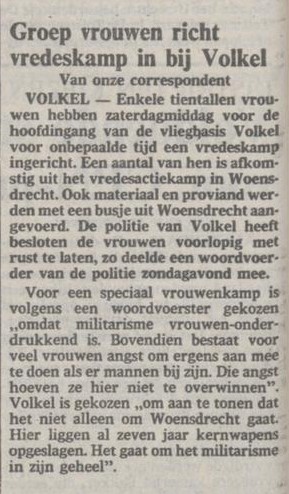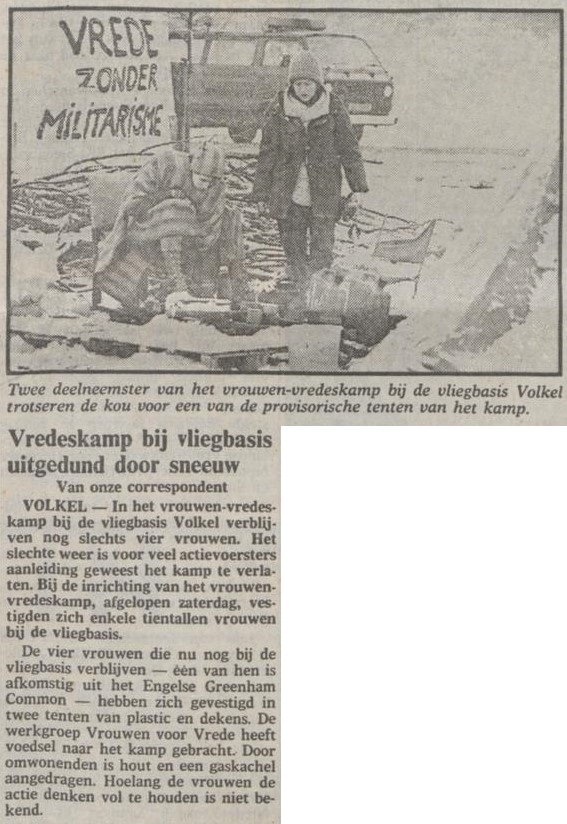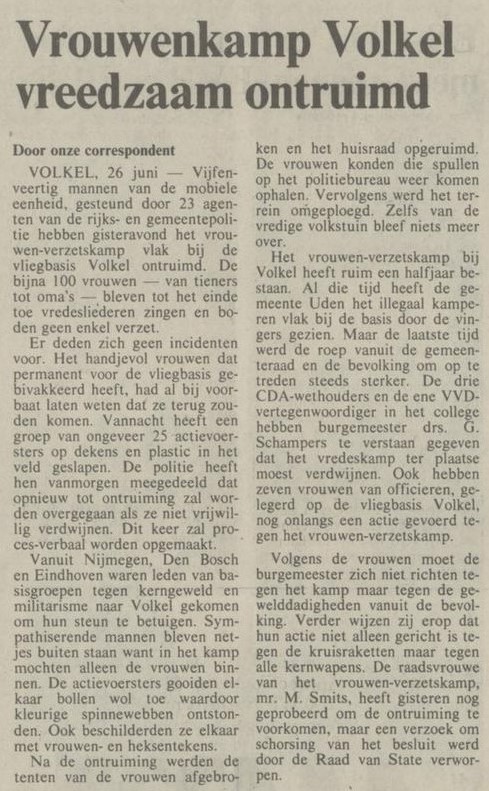GRassroots Movements
The transatlantic women's anti-nuclear movement
Rooted in the protests of the previous decades, a transatlantic movement against nuclear energy emerged during the late 1970s. For those who protested against capitalism, militarism, modernism, and environmental degradation, nuclear weapons were a logical target. As a result, peace camps were established at several locations, including in the Netherlands. Protest camps are effective at combining local with large global issues. In this case that meant that campers could draw attention to both the danger the nuclear weapons posed to the local community—especially if they were to be targeted by an enemy nuclear strike—and global issues like militarism, capitalism, and American empire, of which these bases and weapons were a symptom.
Peace Camps
Part of the anti-nuclear movement were also women’s groups for which nuclear weapons and the bases where they were stored represented a concrete manifestation of the patriarchal militaristic and exploitative system that they were living under. Women on both sides of the Atlantic organized to resist the global systems by targeting these bases. To do so they also established peace camps. In 1981 the first women’s peace camp was established at Greenham Common in England. This camp would serve as an example for other camps including those in Seneca (United States), Comiso (Italy), Pine Gap (Australia) and Soesterberg and Volkel (Netherlands). The fact that these camps consisted of only women gave them the opportunity to become a sort of sanctuary, free from men and more accessible to women. The fact that these women were living in tents in a camp, instead of being in the home that society consigns them to, disrupted normative ideas of daily life and domestic space that these weapons cause. The women’s presence at those militaristic and patriarchal locations was an expression of power and their peaceful actions, during which they sang songs or decorated the bases’ perimeter fences, created a dichotomy between the dark and gloomy military base and the welcoming and friendly women.
Women’s camps in different countries would be in contact with each other and inspire news camps. Participants would visit other women’s camps and hold solidarity actions when other camps faced eviction by the authorities. The women’s camps in the Netherlands should thus be seen in the context of an international women’s movement. As already mentioned, one of these camps was established near the air base in Volkel. Included are some newspaper articles written after the establishment on January 23, 1984, and the evacuation on June 25, 1984.

This newspaper article from De Volkskrant was written just after the establishment of the women’s peace camp in Volkel. It is titled “Group of women established peace camp near Volkel” and makes mention of the connection with another peace camp in the Netherlands, at Woensdrecht, as well as the motivation of the women to establish a women’s camp at that location. One of the women told the reporter that “militarism is oppressive to women.” By establishing this camp, besides the existing one in Woensdrecht, they wanted to show that their actions are not aimed at one single military base but at the global issue of militarism.
De Volkskrant article. “Groep vrouwen richt vredeskamp in bij Volkel.” https://resolver.kb.nl/resolve?urn=ABCDDD:010879578:mpeg21:a0081
Images © De Volkskrant, correspondent, January 23, 1984
International exchanges

This article entitled “Peace camp near air base thinned by snow” mentions that English women from the Greenhom Common Peace Camp were part of the core of the women’s camp in Volkel. Later one of the Dutch women would visit Greenham and write back about her experiences there.
De Volkskrant article: “Vredeskamp bij vliegbasis uitgedund door sneeuw”. https://resolver.kb.nl/resolve?urn=ABCDDD:010879579:mpeg21:a0127
Images © De Volkskrant, correspondent, January 24, 1984
Evacuated
On June 25, 1984, the camp in Volkel was evacuated. This NRC newspaper article titled “Women’s camp Volkel peacefully evacuated” gives an impression of the occurrence. It shows that the support the women in Volkel attracted from other peace groups, the peaceful actions they organized—in which they highlighted the base’s inhumanity—and the fact that the increasing pressure on local authorities to evacuate the camp was one of the main factors that led to the evacuation.
NRC article: “Vrouwenkamp Volkel vreedzaam ontruimd”. https://resolver.kb.nl/resolve?urn=KBNRC01:000027898:mpeg21:a0021
Images © NRC Media, correspondent, June 26, 1984.
